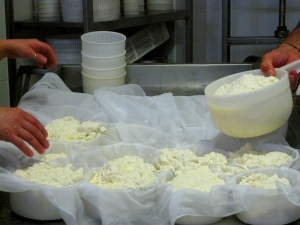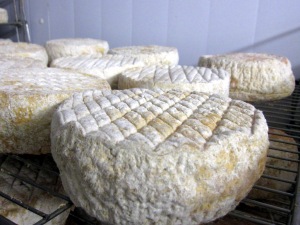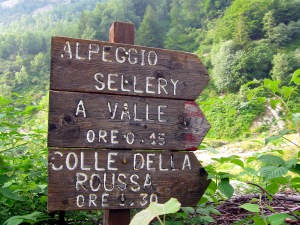Clockwise: Mural of a mountain goat and cow outside Fratelli Lussiana creamery, fresh wheels of cevrin in warm room, foothills of Piedmont, aging wheels of cevrin in cold room
A couple weeks ago while on the Piedmont stage, our class visited Fratelli Lussiana creamery, a cheese producer in Giaveno, about 35 km west of Turin. The primary cheese they produce is cevrin di Coazze, made with half goat and half cow’s milk and aged for 3 months. At the time, I was tired, hot and not in the mood to see yet another farm, but we all fell headlong in love with this cheese producer. After showing us an overview of the cheesemaking process and aging rooms, the lovely Lussiana siblings piled us into a hay-filled tractor and trundled us up a narrow, rocky mountain path, while we tried to keep our balance, yodeled and ducked under overhanging tree branches. Once we reached the mountaintop farm, we were greeted by a herd of seriously dexterous goats, placidly ruminating cows, and the friendliest donkey in the world (who kept sneaking into photos and nuzzling for attention). The farm caretakers welcomed us with fresh wheels of cevrin, salame, bread and red wine, and we ate cheese next to the animals who produced the milk for it, as the sun went down over the Italian Alps. It was one of the best days of my life.
Determined to recapture some of that high, some of my classmates decided to contact Fratelli Lussiana and ask if they would allow us to return for a second visit. Only, this time we wanted to see the cevrin making process, which happens every morning at 6 am. With the 90 minute drive from Bra, this meant that we would be setting out on a 4:30 am road trip. Totally worth it!
After duly waking up at a rather uncivilized hour, the first challenge was figuring out how to get back to the creamery. We were armed with an address of questionable accuracy (the GPS was telling us to go to a different town) and also a phone number. To complicate matters, no one present was terribly fluent in Italian. So, over the next hour, we called three times, and using an amalgamation of broken Italian and French, managed to get within a few streets of the creamery. As we drove through Giaveno, desperately looking for familiar landmarks, we spotted an elderly gentlemen walking briskly down the street. I rolled down a window and asked him for directions to Fratelli Lussiana, and he broke into a toothy grin and began to wave wildly. Seeing our blank reactions, the man said, “You know what, I’d better just point out the way myself, do you mind if I hop in the car?” And before I knew it, I was scooting to make room for a swarthy Italian man in the backseat. We explained that we were students at the University of Gastronomic Sciences, interested in cheesemaking, and he said “Ah yes, of course! Who do you know of the Lussiana brothers? Oh Luigi, yes I know Luigi!” Within a few minutes, he had steered us to the creamery. We thanked him for his help and asked if he needed a ride back. “No no, I walk a lot, 20 km a day! I’ll be just fine.” He stuck his head into the barn to say hello to Luigi, and sauntered off back into town.
Clockwise: agitating the bucket of coagulated milk, pouring out the excess whey, pressed wheels of cheese, placing the curds into perforated buckets
The Lussiana creamery and farm is run by four siblings, Aldo, Maria, Luigi and Elda, who each take turns making cheese, caring for livestock and selling the products. Luigi emerged from the cow shed to greet us and give a little more information about their livestock holdings. The dairy farm includes about 100 cows, which produce about 350 L of milk per day, or 15 L per milking cow. The cattle breed is Barà Pustertaler, originally from the Trentino-Alto Adige region near Austria, with a characteristic white stripe on the back and very high fat content milk (3.84%) well-suited for cheesemaking. Some of the milk is pasteurized, but much of it is left raw for making raw milk cheeses.
To make cevrin, you need a 50/50 mix of goat and cow’s milk. One hundred L of milk will produce 10-12 kilos of cheese. After veal rennet has been added to coagulate the milk, stir the mixture vigorously to break up large pieces, then drain the excess whey at the top. (The leftover whey can be used to make ricotta or seras cheese.) Place the curds into perforated baskets covered with cheesecloth, then flip the molded curds and compress everything into a solid wheel. We watched enraptured as Luigi and his sister Maria deftly put together 20 wheels of cevrin in about five minutes.
Clockwise: aged cevrin, tiers of aging cheeses, decorative cowbells, Lussiana’s cheesemaking awards and trophies
Next, the cheese wheels are salted twice and undergo aging for 3 days in a warm room at 18 C and 50-60% humidity, followed by another 3 months of aging in a cold room at 12 C and 5% humidity. As with the production of salame, a little bit of mold on the exterior is normal, and if unhealthy mold develops it can be washed off. Lussiana also produces toma cheese (aged 6-8 months), fresh ricotta and butter. The cheeses are destined for sale at farmer’s markets, restaurants, Eataly and a couple supermarket chains.
Did I mention that none of us were totally adept at Italian? To disseminate the information to everyone, we had a serious translation chain going, with an Italian speaking French which was translated into English which was translated into Finnish. I imagine this is what it feels like to work in Ferran Adrià’s kitchen.
Clockwise: trailside chapel, waterfall, sign directing you to Alpeggio Sellery, beehives dotting the mountain
After touring the aging rooms, Luigi said that he needed to head to Torino, but we were welcome to hike back up the mountain and see the farm again. We followed his car to the trailhead and began trekking uphill. It takes about 45 min to hike from the parking landing at the bottom to Alpeggio Sellery, though we took our time in dawdling and taking in the view. Along the way, you will see two roadside chapels, a waterfall (look for the sign that says “Oasi di Leuja Scura”), several smaller brooks, beehives, and finally the Alpeggio Sellery farmhouse.
Clockwise: Barà Pustertaler cattle, Alpeggio Sellery farmhouse, Lone Cow ogles at you, Camosciata goats
The farm is something of a surprise when it comes into view, since you have been surrounded by nothing but wilderness and the occasional mountain biker. Suddenly, the remoteness is broken by a sign of civilization and human handiwork. How do you even get to own land on the top of a mountain? I imagine that the roads are pretty much impassable in the winter, but the location is lovely for the summer.
We stopped in to say hello to Daniella, one of the Lussiana employees, and she graciously allowed us to the use the bathroom and buy a wheel of cevrin. Then we continued up the trail, gingerly picking our way through cow pies and rocky terrain.
Clockwise: Mountain top picnic spread, wild blueberries, wild strawberry
About 15 min away from Alpeggio Sellery, there was a water trough for the cattle, who spread out and forage for grass and thistles on the adjacent hills. The air was pristine, heavy with the scent of wild thyme and broken by the occasional crisp breeze. On a flat rock, we laid out a picnic spread of bread, salame, cheese, salads, lentils, cookies and homemade apricot compote. (Pro tip: to keep your beer cold after a long hike, you can freeze it beforehand.) As we munched and relaxed after a hard climb, the cows gazed at us with curiosity and their cowbells tinkled in sonorous harmony. It was almost enough to make me give up internet access.






















Hey wait a minute, this sounds like ALL the fun. You told me you were only having part of it!
Sounds just wonderful! Could you recommend a place to stay as well? Will be travelling this Summer with my elderly parents & young children (10, 7, 3) and would like a break in the countryside.
Thank much.
This was definitely a fun hike, I hope you find the goats too! Alas I don’t really have recs for a place to stay, since we live an hour south and just did a day trip. The nearest major city would be Turin.